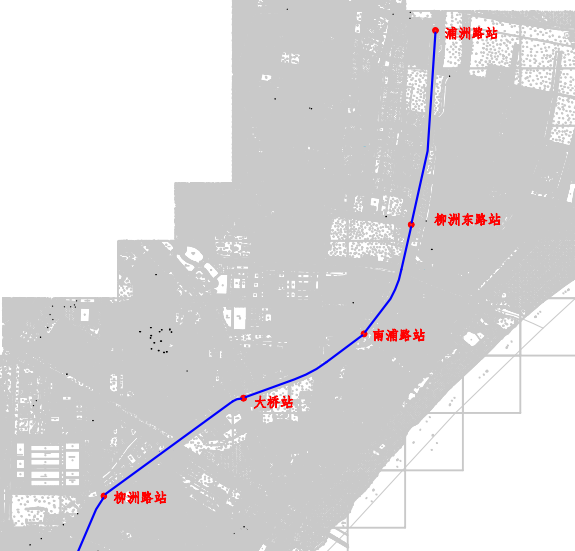南京市轨道交通11号线(2段)线路设计毕业论文
2020-04-25 19:47:15
摘 要
本文通过研究城市轨道交通线路设计的特征、内容和方法,提高城市轨道交通线路设计质量和效率,促进城市轨道交通进一步发展。
本次设计首先对南京市轨道交通11号线规划建设的背景作了一些相关介绍,然后根据选线的基本原则来进行站点的选择、线路走向方案比选,以此确定最终的线路方案。接下来就是进行线路的平纵断面设计。在进行平纵断面设计时要考虑到两者的协调性。在车站设计方面,主要选定车站类型,计算车站规模,然后进行相应的平、剖面设计。在无缝线路设计方面,着重对钢轨和道岔的强度、稳定性两方面的检算,合理设计了长轨条布置。在路基方面,初步确定路基面宽度和路肩高程,进行简单的横断面设计。
关键词:轨道交通 线路设计 平纵断面 车站 无缝线路
Design of Route 11 (Section 2) of Rail Transit in Nanjing
Abstract
By studying the characteristics, contents and methods of urban rail transit line design, this paper aims to improve the quality and efficiency of urban rail transit line design and promote the further development of urban rail transit.
This design firstly introduces the background of the planning and construction of Nanjing rail transit line 11. Then, according to the basic principles of line selection, the station selection and route orientation scheme comparison are made to determine the final route scheme. The next step is to design the horizontal and longitudinal section of the line. The coordination between the two should be considered in the design of horizontal and longitudinal sections. In terms of station design, the station type is selected, the station scale is calculated, and then the corresponding plane and section design is carried out. In terms of CWR design, this paper focuses on checking the strength and stability of rail and turnout, and reasonably designs the layout of long rail. In terms of subgrade, width of subgrade surface and elevation of road shoulder are preliminarily determined, and simple cross section design is carried out.
Key Words: Subway;Line design;Station;Plane and profile sections
目录
摘要 I
Abstract II
第一章 背景资料 1
第二章 线路走向方案比选 2
2.1 浦洲路站至中央商务区站线路走向选择的主要影响因素分析及基本原则 2
2.1.1 主要影响因素 2
2.1.2 基本原则 2
2.2 浦洲路至中央商务区线路走向备选方案设计 4
2.2.1 规划线路走向 4
2.2.2 浦洲路—中央商务区线路走向的方案比选 4
2.3 浦洲路至中央商务区线路走向备选方案综合评价 15
第三章 平面设计 17
3.1 线路平面设计标准的确定 17
3.1.1 线路平面设计要素 17
3.1.2 线路平面位置方案比选 18
3.1.3 线路平面主要技术要素的选择 19
3.2 轨道交通浦洲路至中央商务区线路平面曲线要素计算 23
第四章 纵断面设计 34
4.1 线路纵断面设计标准的确定 34
4.1.1 设计原则 34
4.1.2 主要技术要素的确定 34
4.2 线路竖曲线几何要素计算 37
第五章 轨道交通车站规划设计 50
5.1 沿线站位确定及依据 50
5.2车站类型确定及依据 50
5.3车站客流规模预测 50
5.4 车站长度及站台宽度计算 51
5.4.1车站长度计算 51
5.4.2站台宽度计算 51
5.5规模估算 65
第六章 轨道交通无缝线路设计 67
6.1设计资料 67
6.2单元轨节布置设计 67
6.3轨道强度检算 69
6.3.1计算k值 69
6.3.2计算 70
70
6.3.3计算静弯矩 70
6.3.4计算动弯矩 70
6.3.5计算动弯应力, 71
6.3.6钢轨强度检算 72
6.3.7钢轨强度条件允许温降 73
6.4轨道稳定性检算 74
6.5锁定轨温 75
6.6无缝线路结构组成 76
6.7伸缩区长度的计算 76
6.8缓冲区预留轨缝计算 76
6.8.1长轨条一端伸缩量 76
6.8.2缓冲区标准长度钢轨一端伸缩量 77
6.8.3预留轨缝的计算 77
6.9位移观测桩布置设计 77
6.10防爬设备布置设计 78
6.11道岔区段无缝线路设计 78
6.11.1钢轨强度检算 78
6.11.2稳定性检算 78
6.12隧道区段无缝线路设计 78
第七章 路基设计 80
7.1路基初步设计 80
7.2路肩设计高程 80
7.3路肩本体断面设计 80
7.3.1路基面宽度 80
7.3.2路基边坡 80
7.4路基排水系统设计 80
结束语 82
参考文献 83
致谢 85
相关图片展示:











